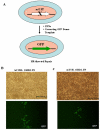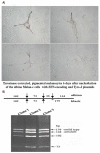Targeted manipulation of mammalian genomes using designed zinc finger nucleases
- PMID: 19635463
- PMCID: PMC2744961
- DOI: 10.1016/j.bbrc.2009.07.112
Targeted manipulation of mammalian genomes using designed zinc finger nucleases
Abstract
Targeted introduction of a double-stranded break (DSB) using designer zinc finger nucleases (ZFNs) in mammalian cells greatly enhances gene targeting - homologous recombination (HR) at a chosen endogenous target gene, which otherwise is limited by low spontaneous rate of HR. Here, we report that efficient ZFN-mediated gene correction occurs at a transduced, transcriptionally active, mutant GFP locus by homology-directed repair, and that efficient mutagenesis by non-homologous end joining (NHEJ) occurs at the endogenous, transcriptionally silent, CCR5 locus in HEK293 Flp-In cells, using designed 3- and 4-finger ZFNs. No mutagenesis by NHEJ was observed at the CCR2 locus, which has ZFN sites that are distantly related to the targeted CCR5 sites. We also observed efficient ZFN-mediated correction of a point mutation at the endogenous mutant tyrosinase chromosomal locus in albino mouse melanocytes, using designed 3-finger ZFNs. Furthermore, re-engineered obligate heterodimer FokI nuclease domain variants appear to completely eliminate or greatly reduce the toxicity of ZFNs to mammalian cells, including human cells.
Figures



Similar articles
-
Creating designed zinc-finger nucleases with minimal cytotoxicity.J Mol Biol. 2011 Jan 21;405(3):630-41. doi: 10.1016/j.jmb.2010.10.043. Epub 2010 Nov 19. J Mol Biol. 2011. PMID: 21094162 Free PMC article.
-
Efficient targeted mutagenesis of the chordate Ciona intestinalis genome with zinc-finger nucleases.Dev Growth Differ. 2012 Jun;54(5):535-45. doi: 10.1111/j.1440-169X.2012.01355.x. Epub 2012 May 28. Dev Growth Differ. 2012. PMID: 22640377
-
Targeted gene addition to a predetermined site in the human genome using a ZFN-based nicking enzyme.Genome Res. 2012 Jul;22(7):1316-26. doi: 10.1101/gr.122879.111. Epub 2012 Mar 20. Genome Res. 2012. PMID: 22434427 Free PMC article.
-
Biological and biomedical applications of engineered nucleases.Mol Biotechnol. 2013 Sep;55(1):54-62. doi: 10.1007/s12033-012-9613-9. Mol Biotechnol. 2013. PMID: 23089945 Review.
-
Custom-designed zinc finger nucleases: what is next?Cell Mol Life Sci. 2007 Nov;64(22):2933-44. doi: 10.1007/s00018-007-7206-8. Cell Mol Life Sci. 2007. PMID: 17763826 Free PMC article. Review.
Cited by
-
Related bifunctional restriction endonuclease-methyltransferase triplets: TspDTI, Tth111II/TthHB27I and TsoI with distinct specificities.BMC Mol Biol. 2012 Apr 10;13:13. doi: 10.1186/1471-2199-13-13. BMC Mol Biol. 2012. PMID: 22489904 Free PMC article.
-
Zinc-finger nucleases: new strategies to target the rat genome.Clin Sci (Lond). 2010 Jul 6;119(8):303-11. doi: 10.1042/CS20100201. Clin Sci (Lond). 2010. PMID: 20615201 Free PMC article. Review.
-
Chromatin structure of two genomic sites for targeted transgene integration in induced pluripotent stem cells and hematopoietic stem cells.Gene Ther. 2013 Feb;20(2):201-14. doi: 10.1038/gt.2012.25. Epub 2012 Mar 22. Gene Ther. 2013. PMID: 22436965 Free PMC article.
-
Origins of Programmable Nucleases for Genome Engineering.J Mol Biol. 2016 Feb 27;428(5 Pt B):963-89. doi: 10.1016/j.jmb.2015.10.014. Epub 2015 Oct 23. J Mol Biol. 2016. PMID: 26506267 Free PMC article. Review.
-
p53 Gene repair with zinc finger nucleases optimised by yeast 1-hybrid and validated by Solexa sequencing.PLoS One. 2011;6(6):e20913. doi: 10.1371/journal.pone.0020913. Epub 2011 Jun 9. PLoS One. 2011. PMID: 21695267 Free PMC article.
References
-
- Capecchi MR. Altering the genome by homologous recombination. Science. 1989;244:1288–1292. - PubMed
-
- Jasin M. Genetic manipulation of genomes with rare-cutting endonucleases. Trends Genet. 1996;12:224–228. - PubMed
-
- Mani M, Kandavelou K, Dy JF, Durai S, Chandrasegaran S. Design, engineering and characterization of zinc finger nucleases. Biochem Biophys Res Commun. 2005;335:447–457. - PubMed
Publication types
MeSH terms
Substances
Grants and funding
LinkOut - more resources
Full Text Sources
Other Literature Sources
Molecular Biology Databases

